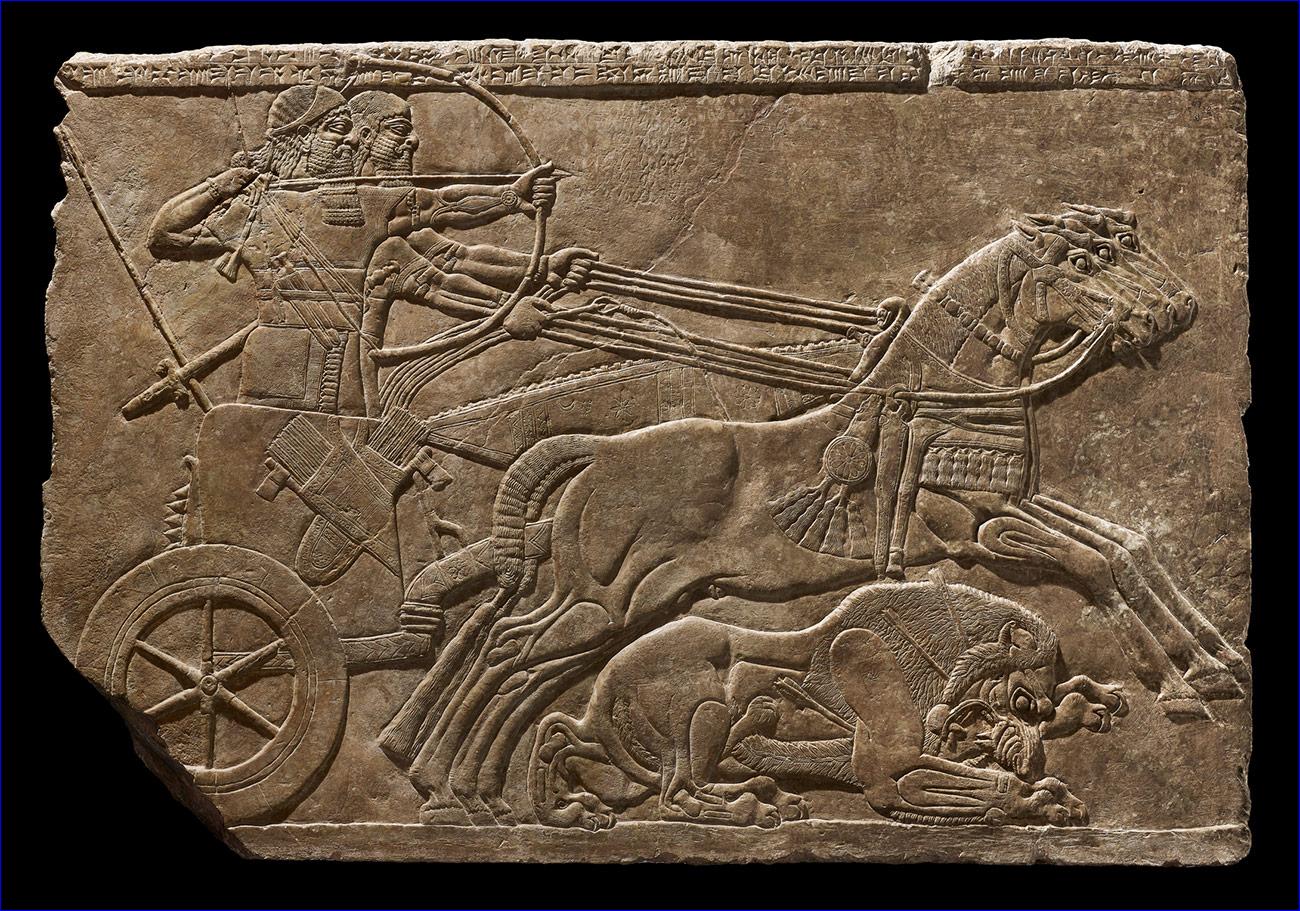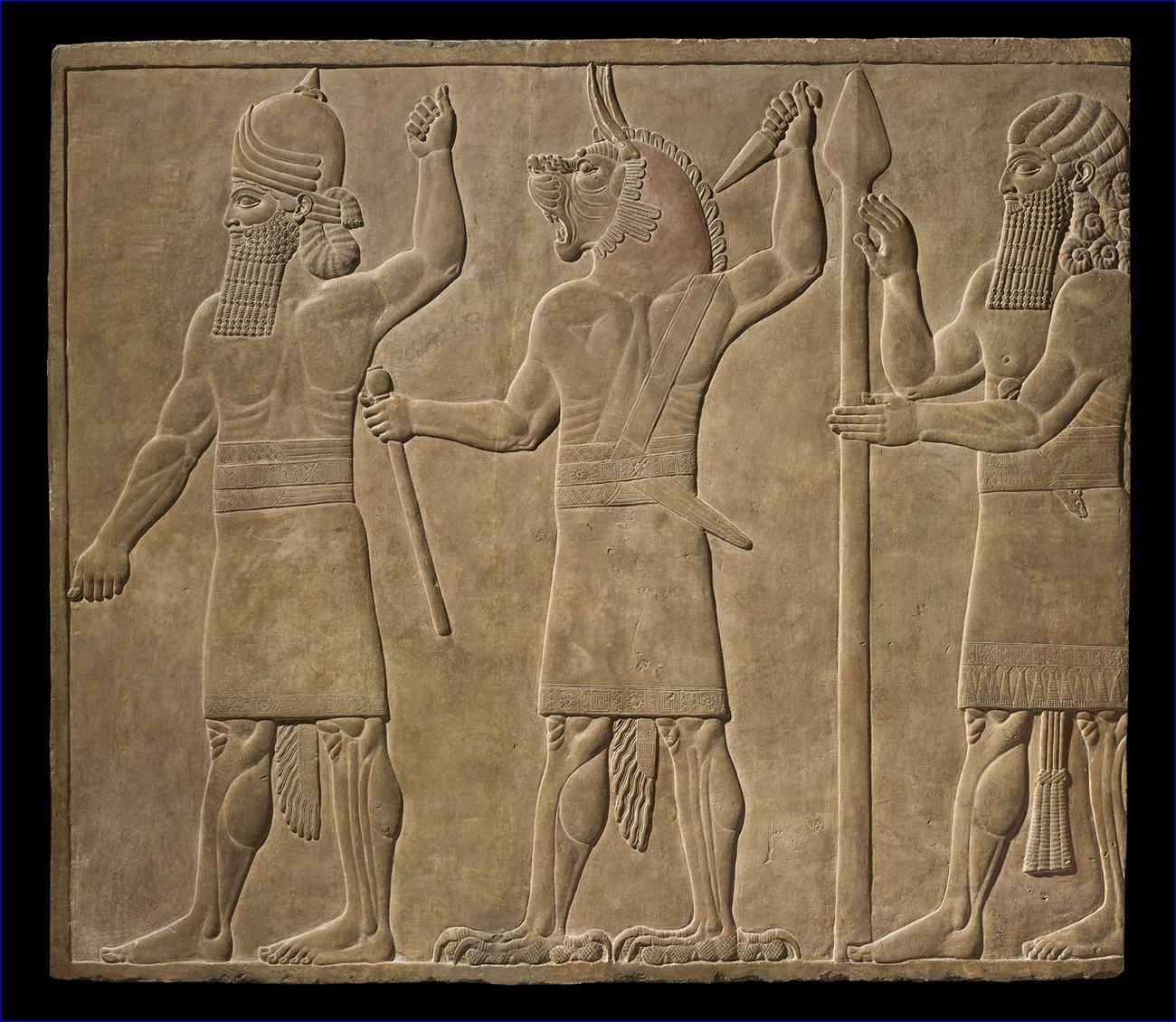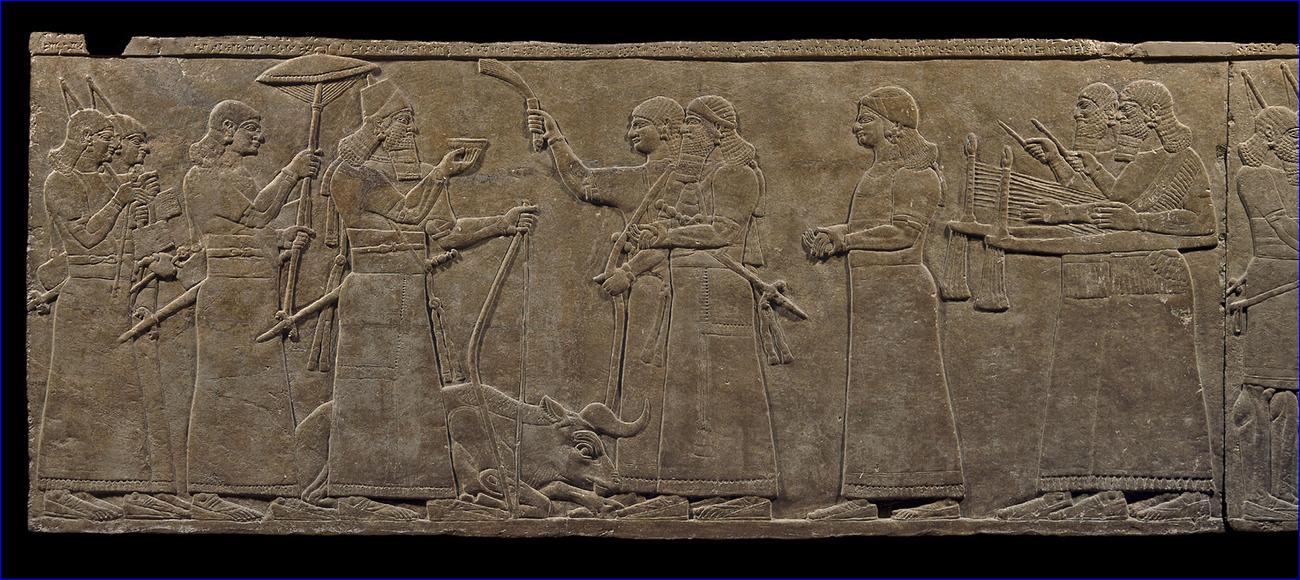


These sculptures took the form of reliefs carved onto gypsum or limestone panels and affixed to interior walls. The reliefs, which were originally painted, stood about two meters (six feet) high and covered the lower portion of palace walls; the wall space above was decorated with painted plaster and glazed bricks.
Thanks to a generous loan from the British Museum, thirteen Assyrian palace reliefs are on view through 2022 at the Getty Villa in the exhibition Assyria: Palace Art of Ancient Iraq.
Here is a short how-to guide for understanding the imagery and narrative techniques of Assyrian palace art, which is rather different from the Greek and Roman art found throughout the rest of the Villa.
Palace Art Depicted Assyria as the Center of the World
The basic purpose of all Assyrian palace decoration was to glorify the king and to present an ideal, ordered world with Assyria at its center. King Ashurbanipal of Assyria, who ruled in the 600s BC, famously declared, "I am...king of the world, king of Assyria."
This ideal world was kept in balance by the king's physical might, by the support he received from the gods, and, importantly, by near-constant warfare. The powerful Assyrian army allowed kings to expand their empire, quell uprisings, and maintain the submission of conquered territories.
The Assyrians did not shy away from depicting the raw brutality of war--or its parallel activity, the hunt--in their art. Be prepared for scenes of violence and bloodshed (both human and animal).
Violence, Luxury, and the Supernatural Were Frequent Themes
Assyrian artists relied on a fairly fixed repertoire of scene types. Once you know what these themes are, you can readily recognize which "type" a particular scene belongs to.
This would have helped ancient viewers easily understand what they were seeing--particularly non-Assyrian visitors to the palaces, who might include foreign dignitaries, war captives, and delegations of tribute bearers. We can image such men walking into the king's throne room and being awed by the sheer power depicted on the walls.
Warfare
Scenes of war and its aftermath make up the largest category of Assyrian reliefs. The king himself sometimes is shown leading his troops into battle, but in other instances he supervises from nearby or receives war booty and captives. Kings also survey conquered territories, put captives to work, and celebrate their victories.

 The Trustees of the British Museum)
The Trustees of the British Museum)
The Hunt
The Assyrian king often hunted lions and other wild animals, which symbolized his ability to subdue powerful opponents and overcome the chaotic forces of nature.

 The Trustees of the British Museum)
The Trustees of the British Museum)
Protective Spirits
The entrances and doorways of Assyrian palaces were decorated with protective deities--either in relief or partially sculpted in the round (as in the case of human-headed, winged bulls and lions known as lamassu).

 The Trustees of the British Museum)
The Trustees of the British Museum)
Activities in or near the Palace
These scenes might include rows of tribute-bearers, banquets, servants and musicians, animals in the palace gardens, or the construction of buildings.

 The Trustees of the British Museum)
The Trustees of the British Museum)
Reliefs Worked Together to Tell Larger Stories
Each Assyrian relief panel belonged to a series that told a larger narrative. Individual panels were not displayed in isolation, like they are today in museum galleries. A single narrative was made up of several panels, and larger thematic cycles could span the four walls of an entire room.
Horizontal bands of cuneiform inscriptions in the Akkadian language often divided scenes into multiple registers (rows) from top to bottom. Short captions were sometimes placed within the scenes themselves.
Artists Used Rich Storytelling Techniques to Convey Complex Events
Assyrian sculptors used different narrative techniques--ways of depicting setting, characters, and action--to tell stories. Narrative techniques included cyclical, synoptic, panoramic, and continuous narratives.
In a cyclical narrative, a story is told in a series of panels, each containing one scene from the story, with some of the same characters appearing from one panel to the next. We're familiar with this technique from cartoon strips and comic books.

 The Trustees of the British Museum)
The Trustees of the British Museum)
In the panel shown above, King Ashurnasirpal (left of center, wearing a royal headdress) celebrates a successful hunt in which he has killed a bull. The preceding episode in this story, which showed the king engaged in the hunt itself, was located on a panel that hung above it (this particular panel is not in the exhibition).
A synoptic narrative condenses all of the moments from a story into a single scene.

 The Trustees of the British Museum)
The Trustees of the British Museum)
Here the Assyrian army besieges an enemy town on a hill in a chaotic scene. Soldiers approach the city walls from left and right. Slain enemies fall from the battlements, while others are impaled on stakes or beheaded. All of the moments of this battle are shown simultaneously, rather than in sequence.
A panoramic narrative shows multiple actions happening simultaneously, but in different places.

 The Trustees of the British Museum)
The Trustees of the British Museum)

 The Trustees of the British Museum)
The Trustees of the British Museum)
This banquet scene of King Ashurbanipal once belonged to a larger composition made up of three registers, which is reconstructed in the illustration above. Each register shows a different part of the palace grounds as the king's banquet is taking place.
The panel at the upper left shows Assyrians taunting captured enemy kings, who are being forced to serve Ashurbanipal. In the central upper panel, the king dines while reclining on a cushioned bench. He and his queen are attended by musicians and fan-bearers.
At the far right, armed guardsmen protect the royal party. The upper register is closest to the palace itself, while the lowest register, which contains no human figures and shows a marshy setting, is the farthest away. This is an example of one way in which Assyrian artists portrayed spatial relationships and landscapes.
Sometimes Assyrian artists combined multiple narrative forms. The lion hunt of Ashurbanipal shown below consists of three registers, which each show a different episode from the hunt (cyclical narrative). But in each of the top two registers, a single lion is shown at different moments of the action in a continuous narrative that progresses from right to left.

 The Trustees of the British Museum)
The Trustees of the British Museum)
In the top register, a lion is released from his cage at the far right. The same lion charges the king and leaps toward him as the king prepares to shoot an arrow from his bow.
In the middle register, a horseman distracts another lion so that the king can seize its tail. Ashurbanipal celebrates his successful hunt in the bottom register, which is very similar to the celebration of Ashurnasirpal's bull hunt from over 200 years earlier (shown above), attesting to the strong continuity of these scene types over long periods of time.
The basic ideals of Assyrian kingship--strength, bravery, military might, support from the gods--endured throughout the empire's history. In Assyria: Palace Art of Ancient Iraq, you can appreciate the change and continuity in how kings expressed these ideals through palace sculpture over more than two centuries.

or register to post a comment.